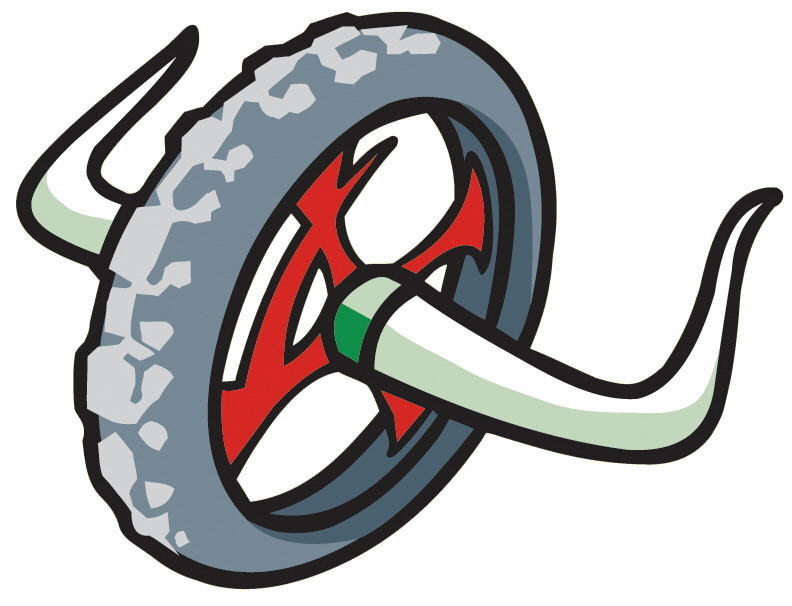There are three things every mountain biker must face: death, taxes and turns. You live on your own with the Grim Reaper and the IRS, but we can help you with your cornering skills.
There are hundreds of different kinds of turning situations, and of course we can't detail how to handle every one, but we can offer you tips that will help you turn smoother, faster and more effectively regardless of the turn.
THE APPROACH
As you enter a turn, adjust your entry speed to match the corner. Ask yourself these questions. Is it banked? Flat? Off-camber? Does the radius change?
If the turn is banked, you need to brake a lot less than if it is off-camber. The more the outside of the turn is angled in your favor, the more tire you will have on the ground, and the more traction you will get. The reverse applies for an off-camber turn.
If the radius is tight, set up quickly, be prepared to apply the brakes and move to the front of the bike. If the radius is wide, don't use too much braking, select the smoothest line and don't position yourself too far forward.
SURFACE CONDITIONS
Once you have read the turn and are braking properly, look at the dirt. Is it hard and slippery, soft and slippery, soft and tacky, rough and tacky, or something else entirely? Evaluating the surface helps determine weight distribution.
Hard: If the turn is slippery, lean forward to get maximum front-wheel traction.
Soft: If it's soft, lean back to counterbalance deceleration.
Tacky: If it's tacky, ride with your weight in the middle of the bike.
Rough: When the ground is rough, stay back and follow the bike. Let the bike bounce around underneath you.
When two conditions are combined in the same turn, simply adapt the best technique for dealing with the corner's specifics. For example, if it's rough and slippery, it's best to keep your weight in the middle of the bike. Yes, it is a compromise between being forward on slippery dirt and back on rough dirt, but it offers you the ability to adjust quickly.
What should you do if you enter the perfect turn line that is soft and tacky? Keep your weight to the back of the bike and lean into the turn instead of steering. The closer to perfect a corner is, the easier it is to carry speed through it. Cornering faster saves precious energy. On a long ride, these savings help increase your overall speed and endurance dramatically.
WHAT TO DO WITH YOUR FEET
Should you keep your foot on the pedal or take it off? Do whatever you want, but here are the rules of thumb.
Foot-out: Taking your inside foot off the pedal (motocross-style) is the easiest way to turn when first starting out. With your foot hanging out, you can use it as a rudder when you get in trouble. The conditions will dictate what you do with your feet. If the turn is tacky, put your inside foot forward, plant it, keep it forward, lean back and sit down. As you exit the turn, pull the foot as you straighten your body.
In slippery conditions, put your foot out as you enter the turn, but don't stick it forward. Instead, hold the foot in line with your body. That way, if the rear wheel breaks loose, you can dab your foot on the ground or use it as a rudder by turning your toe inward and letting your leg slide towards the back of the bike to counteract the slide.
If the turn is rough, your foot should hover just above the ground, acting as a counterbalance. This should aid you in keeping the wheels from breaking loose, but if they do break free, you can always dab your foot to keep from going down.
Feet-up: Once you understand when to put your foot out, you can begin to leave it on the pedals. You might corner faster with your foot out, but you will accelerate out of the corner faster with your feet up.
The biggest difference between being clipped in and being clipped out is how your weight is distributed. When clipped in, the only counterbalance you can produce is the weight of your inside knee and elbow sticking out. To get maximum traction, try using your outside knee and elbow to push down on the bike. This will enhance your ability to get traction. Forward-and-back weight distribution should stay the same whether you are clipped in or not.
THE ART OF TURNING
The art of turning comes in knowing the fine line between maintaining speed through a turn and sliding out. This is done by reading the turn well and braking just enough for the conditions. Add the weight distribution techniques, and you're on your way to being a better rider. With practice, your abilities will increase.
When trying these tips, please wear gloves as well as knee and elbow guards, and always wear your helmet. Practice in a safe place and have fun.
There are hundreds of different kinds of turning situations, and of course we can't detail how to handle every one, but we can offer you tips that will help you turn smoother, faster and more effectively regardless of the turn.
THE APPROACH
As you enter a turn, adjust your entry speed to match the corner. Ask yourself these questions. Is it banked? Flat? Off-camber? Does the radius change?
If the turn is banked, you need to brake a lot less than if it is off-camber. The more the outside of the turn is angled in your favor, the more tire you will have on the ground, and the more traction you will get. The reverse applies for an off-camber turn.
If the radius is tight, set up quickly, be prepared to apply the brakes and move to the front of the bike. If the radius is wide, don't use too much braking, select the smoothest line and don't position yourself too far forward.
SURFACE CONDITIONS
Once you have read the turn and are braking properly, look at the dirt. Is it hard and slippery, soft and slippery, soft and tacky, rough and tacky, or something else entirely? Evaluating the surface helps determine weight distribution.
Hard: If the turn is slippery, lean forward to get maximum front-wheel traction.
Soft: If it's soft, lean back to counterbalance deceleration.
Tacky: If it's tacky, ride with your weight in the middle of the bike.
Rough: When the ground is rough, stay back and follow the bike. Let the bike bounce around underneath you.
When two conditions are combined in the same turn, simply adapt the best technique for dealing with the corner's specifics. For example, if it's rough and slippery, it's best to keep your weight in the middle of the bike. Yes, it is a compromise between being forward on slippery dirt and back on rough dirt, but it offers you the ability to adjust quickly.
What should you do if you enter the perfect turn line that is soft and tacky? Keep your weight to the back of the bike and lean into the turn instead of steering. The closer to perfect a corner is, the easier it is to carry speed through it. Cornering faster saves precious energy. On a long ride, these savings help increase your overall speed and endurance dramatically.
WHAT TO DO WITH YOUR FEET
Should you keep your foot on the pedal or take it off? Do whatever you want, but here are the rules of thumb.
Foot-out: Taking your inside foot off the pedal (motocross-style) is the easiest way to turn when first starting out. With your foot hanging out, you can use it as a rudder when you get in trouble. The conditions will dictate what you do with your feet. If the turn is tacky, put your inside foot forward, plant it, keep it forward, lean back and sit down. As you exit the turn, pull the foot as you straighten your body.
In slippery conditions, put your foot out as you enter the turn, but don't stick it forward. Instead, hold the foot in line with your body. That way, if the rear wheel breaks loose, you can dab your foot on the ground or use it as a rudder by turning your toe inward and letting your leg slide towards the back of the bike to counteract the slide.
If the turn is rough, your foot should hover just above the ground, acting as a counterbalance. This should aid you in keeping the wheels from breaking loose, but if they do break free, you can always dab your foot to keep from going down.
Feet-up: Once you understand when to put your foot out, you can begin to leave it on the pedals. You might corner faster with your foot out, but you will accelerate out of the corner faster with your feet up.
The biggest difference between being clipped in and being clipped out is how your weight is distributed. When clipped in, the only counterbalance you can produce is the weight of your inside knee and elbow sticking out. To get maximum traction, try using your outside knee and elbow to push down on the bike. This will enhance your ability to get traction. Forward-and-back weight distribution should stay the same whether you are clipped in or not.
THE ART OF TURNING
The art of turning comes in knowing the fine line between maintaining speed through a turn and sliding out. This is done by reading the turn well and braking just enough for the conditions. Add the weight distribution techniques, and you're on your way to being a better rider. With practice, your abilities will increase.
When trying these tips, please wear gloves as well as knee and elbow guards, and always wear your helmet. Practice in a safe place and have fun.






 손님
손님
댓글 달기